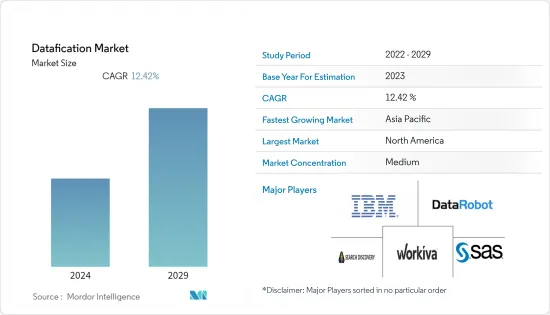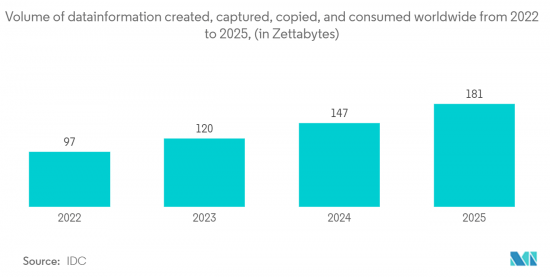 |
市場調查報告書
商品編碼
1408440
資料轉換:市場佔有率分析、產業趨勢與統計、2024年至2029年成長預測Datafication - Market Share Analysis, Industry Trends & Statistics, Growth Forecasts 2024 - 2029 |
||||||
※ 本網頁內容可能與最新版本有所差異。詳細情況請與我們聯繫。
資料轉換市場上一年的市場規模為3,099.7億美元,預計未來五年將達到6,300.1億美元,複合年成長率為12.42%。

主要亮點
- 世界各地產生的資料量持續呈指數級成長。數位科技、物聯網 (IoT)、社群媒體和線上交易的普及每天都會產生大量資料。
- 企業正在認知到資訊在做出明智決策、提高業務效率和獲得競爭優勢方面的重要性,從而推動資料資料的穩步擴張。隨著資料來源的激增和先進分析工具的發展,各行業的公司都在利用資料獲取有用的見解方面進行了大量投資。
- 從穿戴式裝置和智慧恆溫器到工業感測器和自動駕駛汽車,物聯網設備會定期產生資料。即時監控、主動維護、改善使用者體驗都依賴這些資料。物聯網資料被用來改善製造、醫療保健和智慧城市等領域的業務和服務。
- 疫情迫使企業迅速實施遠距辦公、線上銷售、虛擬服務。結果,公司增加了在資料分析和數位基礎設施上的支出。只要公司優先考慮資料主導的決策和敏捷的業務營運,這種數位化趨勢就有望持續下去。
- 資料的最前沿是人工智慧 (Al) 和高階分析。機器學習演算法分析大量資訊以尋找模式、預測結果和自動化決策。在金融和電子商務等領域,人工智慧驅動的洞察用於提供個人化服務、檢測詐欺和簡化流程。
- 在疫情期間,世界各地的組織都認知到資料分析在決策、建立彈性和提供優質服務方面的重要性。 COVID-19 之後,資料市場正在經歷強勁成長,資料主導策略正在成為各行各業的常態。這凸顯了在日益以資料為中心的世界中有效資料管理和嚴格隱私保護的重要性。
資料轉換市場的趨勢
產生資料量的速度
- Facebook、Twitter 和 Instagram 等社交網站每天都會產生數十億條貼文、照片和影片。感測器和智慧家電等物聯網 (IoT) 設備會產生連續的資料流。根據國際數據公司(IDC)的報告,未來三年,全球產生的資料量預計將超過163Zetta位元組(ZB)。
- 每天產生的大量資料正在改變商務策略和消費者體驗。公司正在利用這個資料金礦來更了解消費行為、市場趨勢和業務效率。
- Netflix 和亞馬遜等公司使用客戶資料來提供個人化推薦。這些資料主導的策略可以增加銷售額,同時提高客戶滿意度。透過穿戴式醫療技術和電子健康記錄(EHR) 產生大量病患資料。此資料分析可以改善患者照護並及早發現疾病。
- 組織不僅可以了解過去的資料,還可以使用先進的分析工具和機器學習演算法來預測未來趨勢。這使組織能夠做出資料驅動的決策、改善客戶體驗並簡化流程。
- 資料分析對於金融領域管理風險、確保合規性和改善詐欺偵測至關重要。資料分析使金融機構能夠管理其投資、做出資訊的貸款決策並最大化其投資組合。銀行和其他金融機構使用資料分析來識別非法貿易並評估信用風險,從而節省資金並最大限度地減少財務損失。
- 應對快速都市化的挑戰需要資料驅動的城市規劃和政府。透過評估交通模式、能源使用和公共服務的資料,城市可以改善基礎設施、減少擁塞並提高公民的生活品質。智慧城市計畫還從各種資訊來源收集資料,包括交通感測器、攝影機和氣象站,以最佳化交通流量、能源消耗和公共服務。

北美預計將佔據很大佔有率
- 世界上一些最著名的技術中心都位於北美,尤其美國。像Google這樣每天處理數拍位元資料以改善搜尋引擎和廣告平台的公司誕生於矽谷生態系統。除了產生現金之外,資料分析的這些進步也影響著國際資料趨勢。
- 來自多個來源的廣泛資料生產有助於北美在資料數位化和商業方面的主導地位。物聯網正在美國汽車產業迅速獲得認可,允許從行動物體收集即時資料。特斯拉等公司利用這些資訊來提高自動駕駛能力並遠距離診斷。北美豐富的資料生產源保證了資料的穩定流動,這對資料市場至關重要。
- 為了獲得競爭優勢,北美公司正在利用資料分析的力量。亞馬遜的業界標準建議引擎使用先進的資料分析。他們研究消費者行為和過去的購買歷史來提出產品推薦,從而顯著提高公司收益。北美公司正在大力投資資料分析專業知識和工具,從而形成資料主導的思維方式。
- 北美經濟是多元化的,跨越多個不同的經濟部門,每個部門都有不同的資料要求。這種多樣性將資料市場的應用擴展到銀行、醫療保健、製造和娛樂等行業。由於其廣泛的行業形勢,北美透過針對每個行業需求量身定做的資料分析解決方案,在全球資料市場中獲得了更強大的地位。
資料產業概況
資料數位化市場是參與企業適度分散的市場環境,既有全球性的,也有區域性的參與企業。然而,各個較小的參與企業之間的整合趨勢是顯著的。許多市場參與企業正在透過創新策略增強競爭。該市場的主要企業包括IBM公司、SAS Institute、Workiva等。
2023 年 7 月,HCLTech 宣布了一項突破性解決方案,稱為 HCLTech Advantage Analytics。這項創新旨在將AI(人工智慧)和BI(商業智慧)無縫整合,為企業提供廣泛的服務。目的是增強客戶體驗並改善整體業務成果。 HCLTech Advantage Analytics 利用人工智慧的力量,旨在與 Snowflake 的資料雲配合使用。這個技術中立的平台使 HCLTech Advantage Insights 能夠與 Snowflake 的資料雲無縫協作,為客戶提供人工智慧驅動的見解,從而實現更快、更資訊的決策。
2023 年 7 月,KPM Analytics 發布了 KPMLink,這是一款基於雲端基礎應用程式,用於遠端管理 SpectraStar XT 系列近紅外線(NIR) 分析儀。這項創新工具使用戶和管理員能夠存取每台設備的全面診斷歷史記錄,從而深入了解健康資料。此外,關鍵設備健康資料透過 KPMLink 安全儲存在現場和雲端,確保資料完整性並使用戶能夠根據可信任測量資料做出決策。
其他福利
- Excel 格式的市場預測 (ME) 表
- 3 個月分析師支持
目錄
第1章簡介
- 研究假設和市場定義
- 調查範圍
第2章調查方法
第3章執行摘要
第4章市場洞察
- 市場概況
- 產業吸引力-波特五力分析
- 買方議價能力
- 供應商的議價能力
- 新進入者的威脅
- 替代品的威脅
- 競爭公司之間的敵對關係
- 產業價值鏈分析
- COVID-19 市場影響評估
第5章市場動態
- 市場促進因素
- 產生資料量的速度。
- 對資料洞察的需求不斷成長
- 市場抑制因素
- 缺乏熟練人才
第6章市場區隔
- 按類型
- 行為資料
- 社群資料
- 地理空間資料轉換
- 交易資料
- 感測器資料轉換
- 按用途
- 區塊鏈
- AIops
- 認知運算
- 邊緣運算
- 菲諾普斯
- 其他用途
- 按行業分類
- BFSI
- 醫療保健
- 資訊科技/通訊
- 政府/國防
- 零售
- 其他行業
- 按地區
- 北美洲
- 歐洲
- 亞太地區
- 中美洲和南美洲
- 中東/非洲
第7章 競爭形勢
- 公司簡介
- Workiva
- IBM Corporation
- Matillion
- Search Discovery, Inc.
- Xceptor
- SAS Institute Inc
- DataRobot, Inc.
- Crosser
第8章投資分析
第9章 市場機會及未來趨勢

The datafication market was valued at USD 309.97 billion in the previous year and is expected to register a CAGR of 12.42%, reaching USD 630.01 billion by the next five years.
Key Highlights
- Owing to the fact that the amount of data generated worldwide continues to grow exponentially. The proliferation of digital technologies, the Internet of Things (IoT), social media, and online transactions all contribute to the massive daily data volume.
- Organizations recognize the significance of data in making informed decisions, enhancing operational efficiency, and obtaining a competitive edge, fueling that datafication market's steady expansion. Companies across industries are spending extensively on using data to derive useful insights due to the proliferation of data sources and the development of advanced analytics tools.
- IoT devices regularly generate data, from wearables and smart thermostats to industrial sensors and self-driving cars. Real-time monitoring, proactive maintenance, and improved user experiences all make use of this data. IoT data is used by sectors like manufacturing, healthcare, and smart cities to improve operations and services.
- The pandemic compelled businesses to adopt remote work, online sales, and virtual services quickly. As a result, they upped their spending on data analytics and digital infrastructure. As long as businesses prioritize data-driven decision-making and agile business operations, this digitalization trend is anticipated to continue.
- The forefront of datafication is artificial intelligence (Al) and advanced analytics. In order to find patterns, anticipate outcomes, and automate decision-making, machine learning algorithms analyze massive amounts of information. Sectors like finance and e-commerce use AI-powered insights to give individualized services, spot irregularities, and streamline procedures.
- During the pandemic, the significance of data analytics in forming decisions, boosting resilience, and offering superior services was acknowledged by organizations worldwide. In the aftermath of COVID-19, the datafication market is experiencing robust growth, with data-driven strategies becoming the norm across a wide spectrum of industries. This underscores the utmost importance of effective data management and stringent privacy safeguards in an increasingly data-centric world.
Datafication Market Trends
The pace at which volume of data being generated
- Daily, billions of posts, photographs, and videos are created on social networking sites like Facebook, Twitter, and Instagram. Data streams are continuously produced by Internet of Things (IoT) devices like sensors and smart appliances. By the next three years, the amount of data generated globally is anticipated to exceed 163 zettabytes (ZB), as per reports by the International Data Corporation (IDC).
- Business strategy and consumer experiences are changing due to the sheer volume of data generated every day. Businesses are making use of this data gold mine to learn more about consumer behavior, market trends, and operational efficiency.
- Personal recommendations are made using client data by businesses like Netflix and Amazon. This data-driven strategy raises sales while enhancing customer happiness. Large amounts of patient data are produced through wearable medical technology and electronic health records (EHRs). This data analysis can result in improved patient care and early disease detection.
- Organizations can predict future trends using sophisticated analytics tools and machine learning algorithms in addition to understanding historical data. This allows organizations to make data-based decisions, improve client experiences, and streamline processes.
- Data analytics are essential in the financial sector for managing risks, guaranteeing compliance, and improving fraud detection. It enables institutions to manage investments, make informed lending decisions, and maximize their portfolios. Banks and other financial institutions use data analytics to identify fraudulent transactions and evaluate credit risk, which saves money and minimizes financial losses.
- Addressing the problems of rapid urbanization requires data-driven urban planning and administration. Cities can improve infrastructure, ease congestion, and improve the quality of life for citizens by evaluating data on traffic patterns, energy use, and public services. Also, to optimize traffic flow, energy consumption, and public services, smart city programs gather data from a variety of sources, including traffic sensors, cameras, and weather stations.

North America Expected to Witness Significant Share
- Some of the most well-known technology centers in the world are located in North America, primarily the United States. Companies like Google, which processes petabytes of data daily to improve its search engines and advertising platforms, were born in Silicon Valley's ecosystem. In addition to generating cash, these data analytics advancements also have an impact on international datafication trends.
- The widespread production of data from many sources contributes to North America's dominance in the datafication business. The IoT is being quickly embraced by the American automotive sector, allowing for the collection of real-time data from moving objects. This information is used by businesses like Tesla to improve the capabilities of autonomous driving and conduct remote diagnostics. The plethora of data production sources in North America guarantees a steady stream of data, which is essential to the market for datafication.
- To acquire a competitive edge, North American enterprises have embraced the power of data analytics. An industry standard, Amazon's recommendation engine uses advanced data analytics. To make product recommendations, it examines consumer behavior and past purchases, greatly boosting the company's revenue. North American Businesses are heavily invested in data analytics expertise and tools as a result of the data-driven mentality that permeates them.
- The economy of North America is diverse, spanning several different economic sectors with various data requirements in each. Due to this diversity, the datafication market's application has expanded into industries including banking, health care, manufacturing, and entertainment. Due to its broad industrial landscape, North America has a stronger position in the global datafication market because of data analytics solutions that are specifically adapted to each sector's needs.
Datafication Industry Overview
The datafication market comprises a mix of global and regional players, resulting in a moderately fragmented market landscape. However, there is a noticeable trend towards consolidation among various smaller players. Many market participants are gaining a competitive edge through innovative strategies. Key players in this market include IBM Corporation, SAS Institute, and Workiva, among others.
In July 2023, HCLTech introduced a groundbreaking solution known as HCLTech Advantage Analytics. This innovation aims to offer businesses a wide range of services by seamlessly integrating AI (artificial intelligence) and BI (business intelligence). The objective is to enhance customer experiences and improve overall business outcomes. HCLTech Advantage Analytics harnesses the power of AI and is designed to work in conjunction with Snowflake's Data Cloud. This technology-neutral platform allows HCLTech Advantage Insights to seamlessly interact with Snowflake's Data Cloud, providing clients with AI-infused insights that empower quick and well-informed decision-making.
In July 2023, KPM Analytics unveiled KPMLink, a cloud-based application tailored for the remote management of its SpectraStar XT series Near-Infrared (NIR) analyzers. This innovative tool allows users and management to access comprehensive diagnostic histories for each instrument, ensuring robust health data insights. Furthermore, critical instrument health data is securely stored both on-site and in the cloud through KPMLink, ensuring data integrity and providing users with the confidence to base their decisions on reliable measurement data.
Additional Benefits:
- The market estimate (ME) sheet in Excel format
- 3 months of analyst support
TABLE OF CONTENTS
1 INTRODUCTION
- 1.1 Study Assumptions and Market Definition
- 1.2 Scope of the Study
2 RESEARCH METHODOLOGY
3 EXECUTIVE SUMMARY
4 MARKET INSIGHTS
- 4.1 Market Overview
- 4.2 Industry Attractiveness - Porter's Five Forces Analysis
- 4.2.1 Bargaining Power of Buyers
- 4.2.2 Bargaining Power of Suppliers
- 4.2.3 Threat of New Entrants
- 4.2.4 Threat of Substitutes
- 4.2.5 Intensity of Competitive Rivalry
- 4.3 Industry Value Chain Analysis
- 4.4 Assessment of the Impact of COVID-19 on the Market
5 MARKET DYNAMICS
- 5.1 Market Drivers
- 5.1.1 The pace at which volume of data being generated.
- 5.1.2 The growing demand for insights from data
- 5.2 Market Restraints
- 5.2.1 Lack of Skilled Resources
6 MARKET SEGMENTATION
- 6.1 By Type
- 6.1.1 Behavioral Datafication
- 6.1.2 Social Datafication
- 6.1.3 Geospatial Datafication
- 6.1.4 Transactional Datafication
- 6.1.5 Sensor Datafication
- 6.2 By Application
- 6.2.1 Blockchain
- 6.2.2 AIops
- 6.2.3 Cognitive Computing
- 6.2.4 Edge Computung
- 6.2.5 FinOps
- 6.2.6 Other Applications
- 6.3 By End-user Vertical
- 6.3.1 BFSI
- 6.3.2 Healthcare
- 6.3.3 IT &Telecom
- 6.3.4 Government and defense
- 6.3.5 Retail
- 6.3.6 Other End-user Verticals
- 6.4 By Geography
- 6.4.1 North America
- 6.4.2 Europe
- 6.4.3 Asia-Pacific
- 6.4.4 Latin Amerca
- 6.4.5 Middle East & Africa
7 COMPETITIVE LANDSCAPE
- 7.1 Company Profiles
- 7.1.1 Workiva
- 7.1.2 IBM Corporation
- 7.1.3 Matillion
- 7.1.4 Search Discovery, Inc.
- 7.1.5 Xceptor
- 7.1.6 SAS Institute Inc
- 7.1.7 DataRobot, Inc.
- 7.1.8 Crosser













